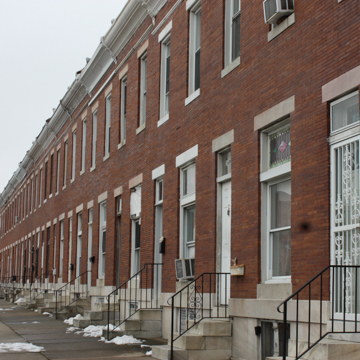The row of houses along the south side of this block, built by large-scale developer Walter Westphal, is touted as the longest in Baltimore. A protracted, planar block of fifty two-story, two-bay-wide red brick row houses flanked by corner stores creates an impressive unified street front. Adding to its visual impact, the block appears as a face-off between two quintessential Baltimore housing forms, these red brick houses with contrasting white marble basement, lintels, and front stoop and similar units faced with Formstone, across the street.
White marble steps and other details are an identifying feature of Baltimore’s row housing. Locally quarried Beaver Dam marble added a level of distinction that became a source of pride for many lower- to middle-income homeowners. Formstone, on the other hand, is a faux stone veneer that was developed in Baltimore in 1937 by L. Albert Knight (it is similar to a product first developed in Columbus, Ohio, in 1929). Touted as maintenance free, energy efficient, and fireproof, Formstone was applied as a resurfacing material to untold numbers of the city’s row houses. While at the time it was viewed as an upgrade due to its resemblance to more expensive stone, it has since been criticized as undermining historic character, resulting in costly removals. Nonetheless, Formstone has long been a recognizable component of Baltimore’s row house landscape.


